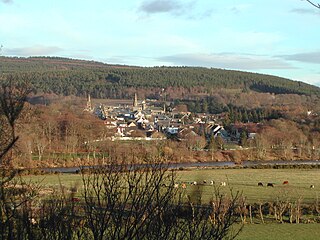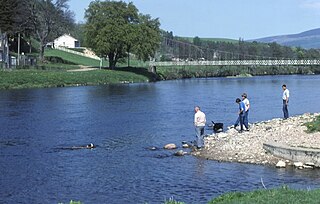
Moray is one of the 32 Local Government council areas of Scotland. It lies in the north-east of the country, with coastline on the Moray Firth, and borders the council areas of Aberdeenshire and Highland.

Mary, Queen of Scots is a 1971 British Universal Pictures biographical film based on the life of Mary, Queen of Scots, written by John Hale and directed by Charles Jarrott. Leading an all-star cast are Vanessa Redgrave as the title character and Glenda Jackson as Elizabeth I. Jackson had previously played the part of Elizabeth in the BBC TV drama Elizabeth R, screened in February and March 1971, the first episode of which was also written by Hale.

James Stewart, 1st Earl of Moray a member of the House of Stewart as the illegitimate son of King James V, was Regent of Scotland for his half-nephew, the infant King James VI, from 1567 until his assassination in 1570.

The title Earl of Moray ("Murray") has been created several times in the Peerage of Scotland. It has been held by Clan Stewart since the 16th century, when James Stewart, illegitimate son of James V, was granted the title.

Lord Gray is a title in the Peerage of Scotland. The Barony of Gray was created circa July 1445 for the Scottish diplomat and politician Sir Andrew Gray. The first Lord Gray was a hostage in England for the good conduct of James I of Scotland from 1424 to 1427, and was one of the knights who accompanied Lady Margaret Stewart to France for her marriage to Louis XI of France in 1436. He was also a Commissioner to England between 1449 and 1451, Master of the Household to James II of Scotland in 1452, and a Warden of the Marches in 1459. In June 1489 King James IV granted to Andrew, Lord Gray, the lands and Barony of Lundie [RGS.II.1860].
Mosstodloch is a small village in Moray, Scotland, lying near the A96 between Fochabers and Elgin on the west bank of the River Spey.
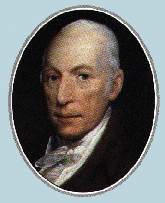
Alexander Gordon, 4th Duke of Gordon, KT, styled Marquess of Huntly until 1752, was a Scottish nobleman, described by Kaimes as the "greatest subject in Britain", and was also known as the Cock o' the North, the traditional epithet attached to the chief of the Gordon clan.
The Kininvie distillery is a distillery in Dufftown, Moray, which produces single malt Scotch whisky. The distillery is owned by William Grant & Sons and the product from the distillery is used in their blended malt and blended whisky brands.

Agnes Keith, Countess of Moray was a Scottish noblewoman having been the eldest daughter of William Keith, 4th Earl Marischal and Margaret Keith. She was the wife of James Stewart, 1st Earl of Moray, Regent of Scotland and the illegitimate half-brother of Mary, Queen of Scots, making her a sister-in-law of the Scottish queen. As the wife of the regent, Agnes was the most powerful woman in Scotland from 1567 until her husband's assassination in 1570.
William Christie was a Scottish clergyman, inaugural Dean of the United Diocese of Moray, Ross, and Caithness, having been the Dean of Ross since 1860.
Events from the year 1886 in Scotland.

The Fray Bentos food brand is associated with tinned processed meat products, originally corned beef and, latterly, meat pies. The brand has been sold in the United Kingdom, other European countries, and Australia. Created in the latter half of the 19th century, the name is derived from the port of Fray Bentos in Uruguay where the products were originally processed and packaged until the 1960s. The brand is now owned in the UK by Baxters, which manufactures the product range in Scotland. Additionally, the Campbell Soup Company manufactures and sells Fray Bentos branded steak and kidney pies in Australia.
Susan Elizabeth MacDonald is a Scottish Anglican priest. She has been Rector of Christ Church, Morningside, Edinburgh since 2007. From 2012 to March 2017, she also served as the Dean of Edinburgh.
Events from the year 1806 in Scotland.

Spey Bay railway station was a railway station in Spey Bay, Moray. The railway station was opened by the Great North of Scotland Railway (GNoSR) on its Moray Firth coast line in 1886, served by Aberdeen to Elgin trains. The station was originally named Fochabers-on-Spey railway station on 1 May 1886. In November 1893 it became Fochabers railway station, Fochabers and Spey Bay railway station on 1 January 1916 before finally becoming on 1 January 1918 Spey Bay railway station. It closed to regular passenger traffic on 6 May 1968 on the same date as the line itself.
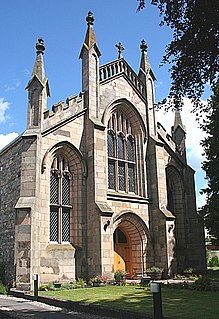
St Mary's, Fochabers is a Roman Catholic Church in the village of Fochabers, Moray, in Scotland and is a part of the RC Diocese of Aberdeen. The building is significant for the high quality of its altar and stained glass windows.It is an active parish church served from Buckie with regular weekly Sunday Mass at 10.00 am.

Gordon Chapel is a nineteenth century church in Fochabers, Scotland. It is part of the Scottish Episcopal Church, under the governance of the United Diocese of Moray, Ross and Caithness. Designated as a category A listed building, it was originally built in the 1830s by Archibald Simpson, and extensively renovated by Alexander Ross in the 1870s, and features the largest collection of Pre-Raphaelite stained glass windows in Scotland.
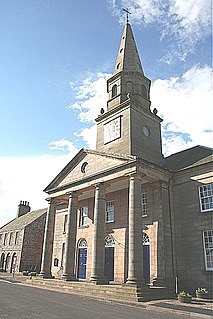
Bellie Kirk is a Georgian church of neoclassical design in Fochabers, Scotland, built in 1798 for 4th Duke of Gordon. It has been in continuous use as a place of worship within the Church of Scotland, and is designated as a Category A listed building.


